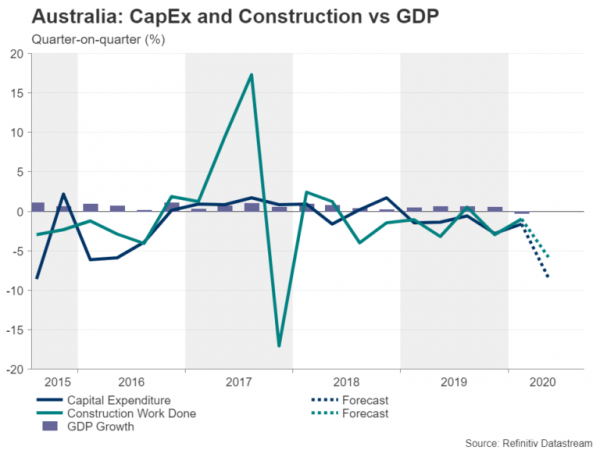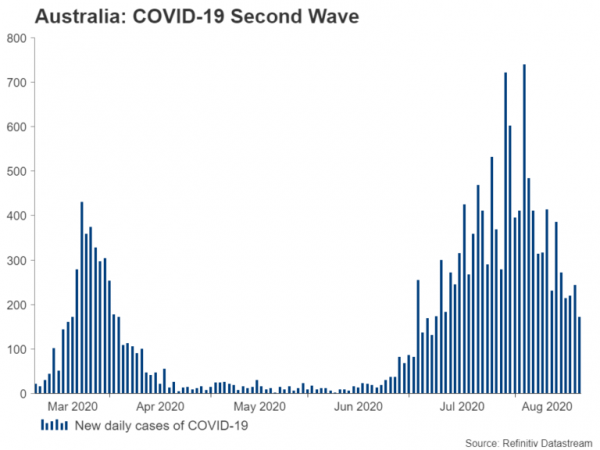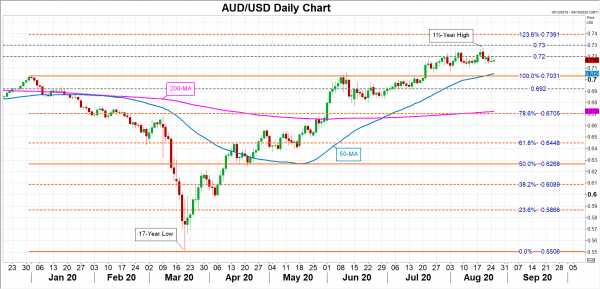Australia has yet to publish its second quarter GDP reading (due in a week’s time) and there will be two precursors ahead of it: quarterly construction output is out on Wednesday at 01:30 GMT and capital expenditure will hit the markets on Thursday at the same time. The data are almost certainly expected to underscore predictions that the Australian economy entered its first recession in nearly three decades in the first half of 2020. But that may not be enough to deter the bullish local dollar from scaling fresh heights as markets remain firmly in risk-on mode.
Construction and capex likely tumbled in Q2
The coronavirus pandemic did what the 2008 Financial Crisis couldn’t do – end Australia’s record run of uninterrupted economic growth. A nationwide shutdown in April and early May is expected to have crippled the economy in the three months to June. The first glimpse of the economic cost of those virus restrictions will come from Wednesday’s construction data. Construction work done in the second quarter is projected to have shrunk by 5.8% from the prior period, which would mark it the eighth straight quarter of falling construction output.
Capital expenditure is not expected to have fared any better. Business spending is forecast to have plummeted by 8.4% over the quarter, extending the worrying stretch of declining investment for a possible sixth quarter.
Is recovery faltering?
However, despite the anticipated gloomy numbers, the overall hit to the Australian economy will probably be less severe than most of its peers in the advanced world. China’s quick rebound in Q2 has meant demand for Australia’s biggest export – resources – has not been as significantly affected by the global downturn as exports of many other goods and services have.
But the underlying picture for the Australian economy is still somewhat worrisome and the second wave of infections currently sweeping through the country will likely hamper the recovery efforts. The flash PMI prints for August already point to the rebound slowing, if not faltering, due to the re-imposition of a full lockdown in the state of Victoria and tightened restrictions in the other states.
Aussie eyes $0.73 but risk of pullback
Hence, any disappointment in the data could fuel doubts about the recovery, putting a cap on the Australian dollar’s impressive uptrend. The area around $0.72 has already proven to be quite sticky for the aussie and a climb above $0.73 may be a step too far for the bulls. Should the aussie be unable to advance beyond recent 1½-year highs, it could suffer a pullback towards the 50-moving average in the $0.7050 region, with the next support seen around $0.6920.
Nevertheless, if the optimism for a virus vaccine and hopes for additional stimulus continue to support risk assets, the aussie could soon overcome the $0.73 barrier as well. In the medium term however, a break above $0.7391, which is the 123.6% Fibonacci extension of the January-March downtrend, is needed to reinforce the bullish outlook.
Can RBA stay not very dovish for much longer?
But while the upcoming releases may generate some volatility in aussie price action in a subdued week, a more important event on investors’ radar is the next Reserve Bank of Australia policy meeting on September 1. The RBA has so far maintained a not-so-dovish policy stance even as the country battles a major virus flare-up. Any change in tone therefore at the September meeting about the need for additional monetary stimulus could still strike a blow to the aussie rally.














